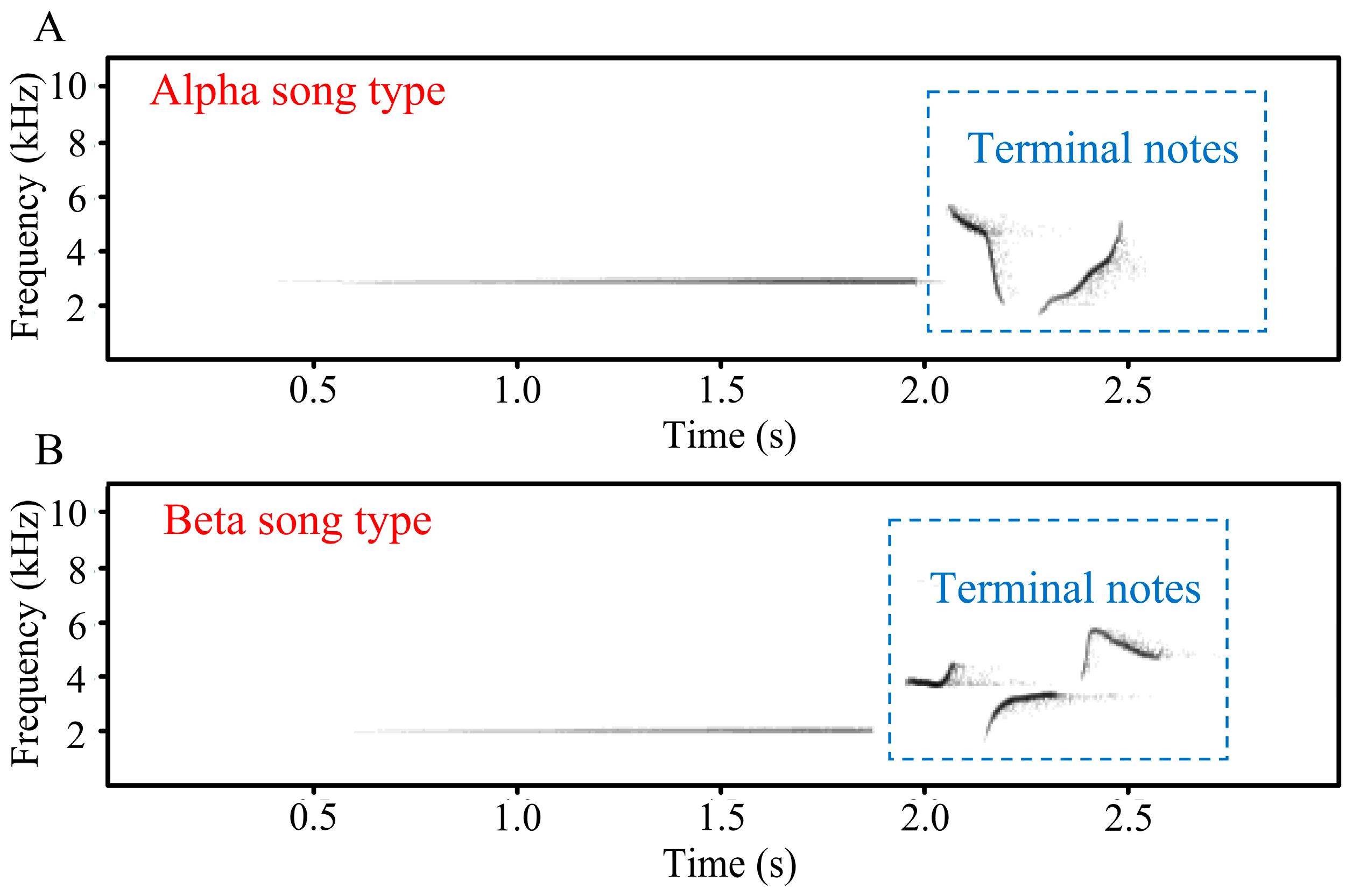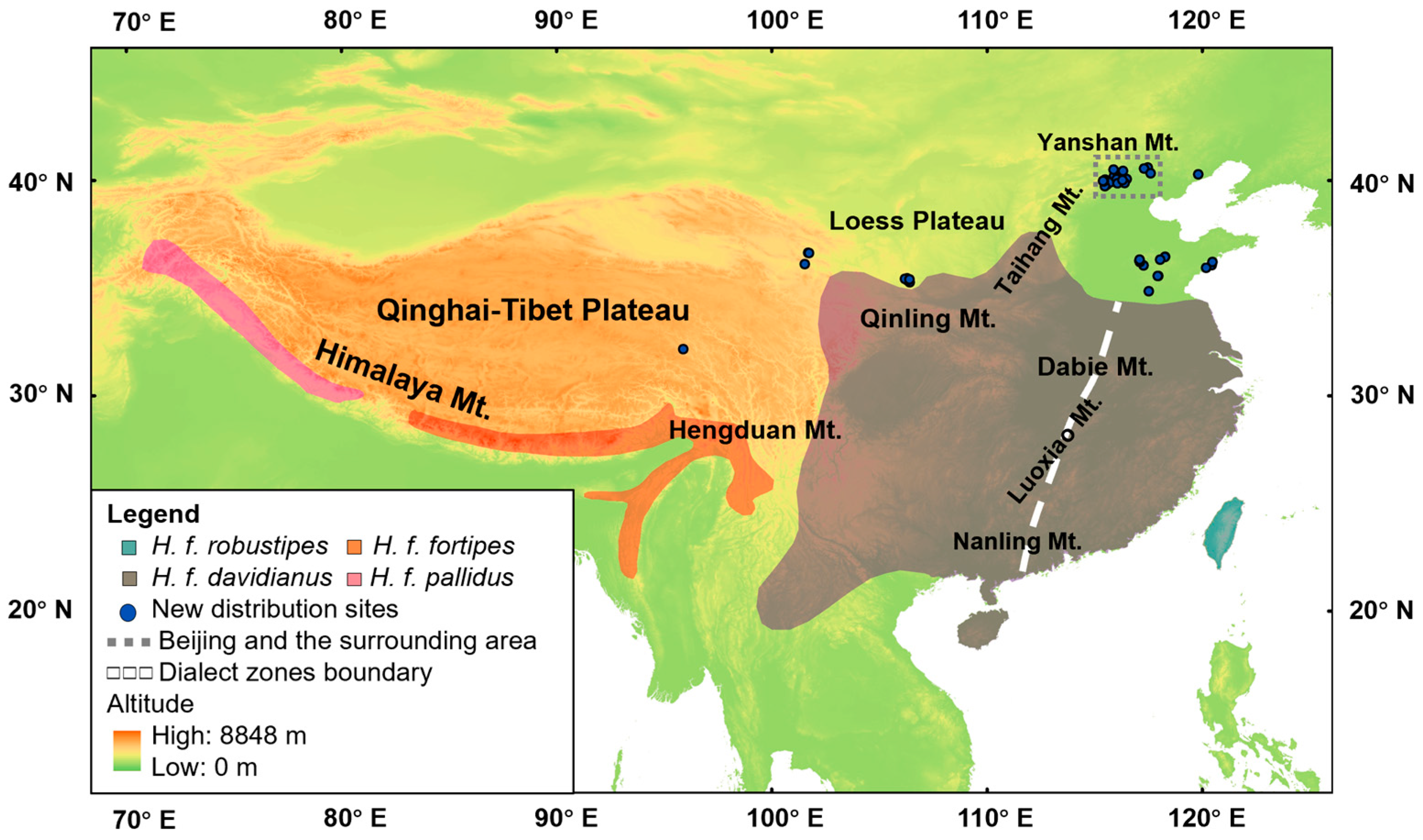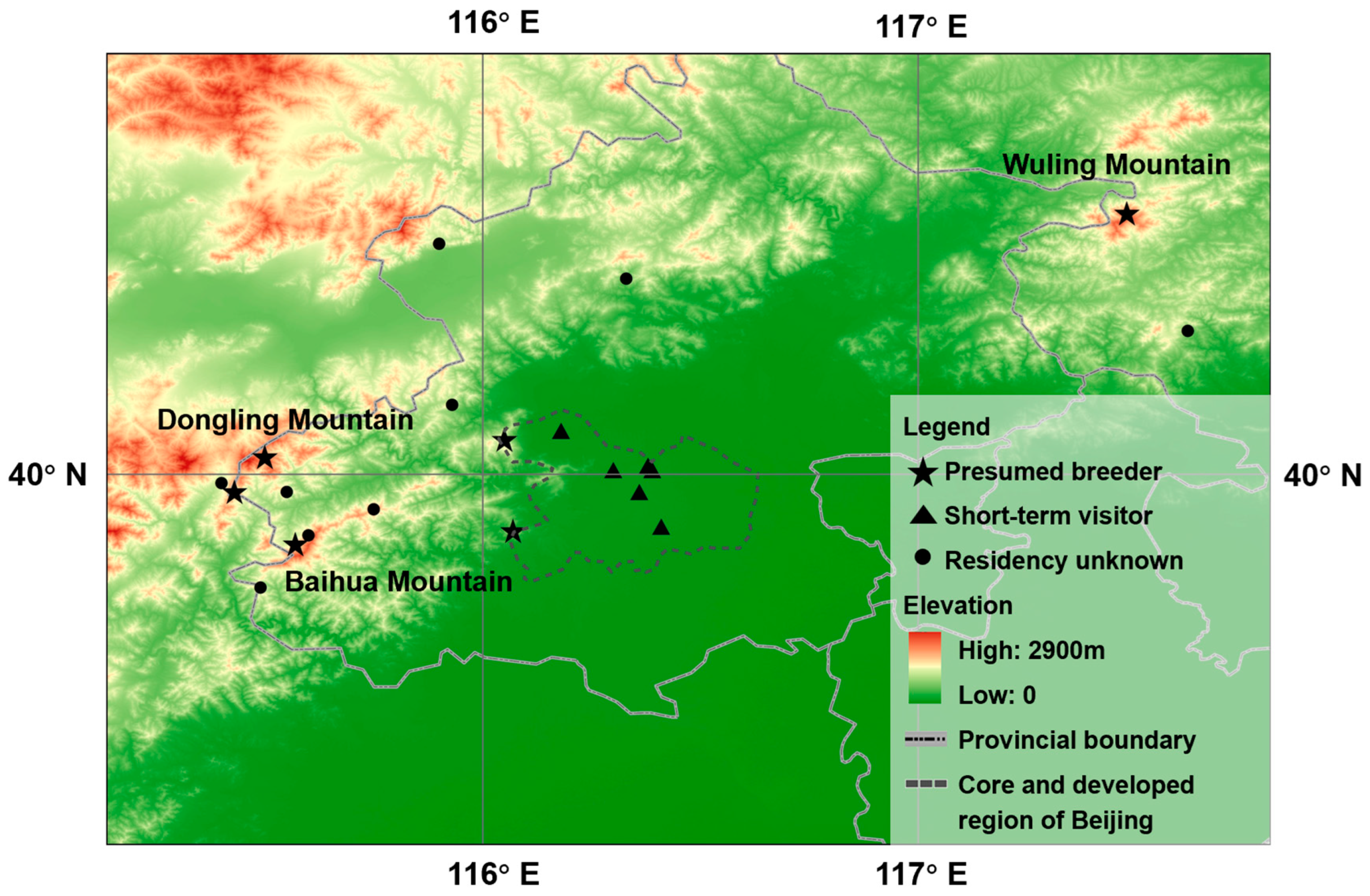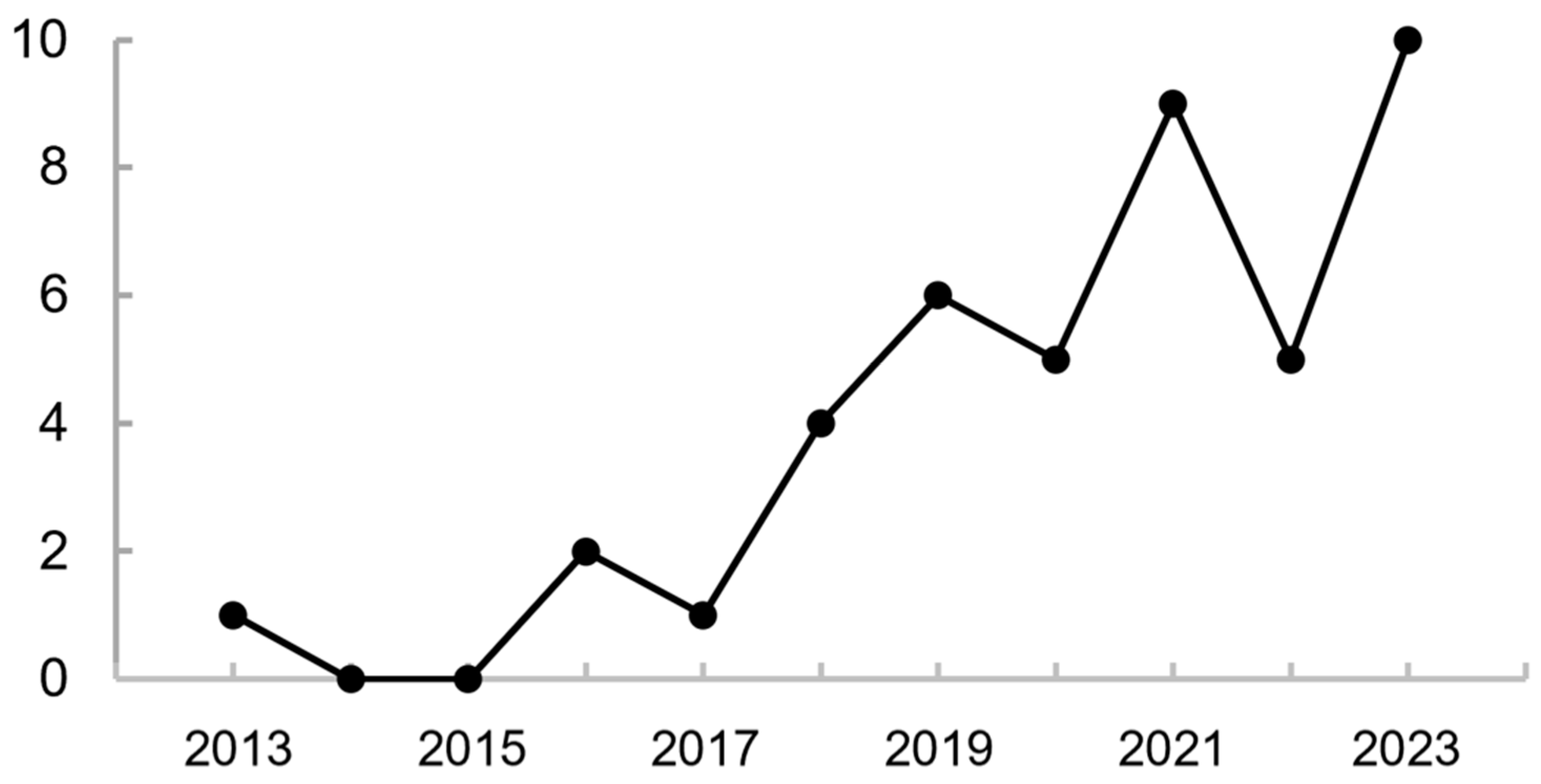Recent Northward Expansion of a Passerine Bird Species, Brownish-Flanked Bush Warbler (Horornis fortipes)
Abstract
:Simple Summary
Abstract
1. Introduction
2. Materials and Methods
3. Results
4. Discussion
5. Conclusions
Supplementary Materials
Author Contributions
Funding
Institutional Review Board Statement
Informed Consent Statement
Data Availability Statement
Acknowledgments
Conflicts of Interest
References
- Newbold, T.; Hudson, L.N.; Hill, S.L.L.; Contu, S.; Lysenko, I.; Senior, R.A.; Borger, L.; Bennett, D.J.; Choimes, A.; Collen, B.; et al. Global effects of land use on local terrestrial biodiversity. Nature 2015, 520, 45–50. [Google Scholar] [CrossRef] [PubMed]
- Walther, G.R.; Post, E.; Convey, P.; Menzel, A.; Parmesan, C.; Beebee, T.J.C.; Fromentin, J.M.; Hoegh-Guldberg, O.; Bairlein, F. Ecological responses to recent climate change. Nature 2002, 416, 389–395. [Google Scholar] [CrossRef] [PubMed]
- Khaliq, I.; Hof, C.; Prinzinger, R.; Boehning-Gaese, K.; Pfenninger, M. Global variation in thermal tolerances and vulnerability of endotherms to climate change. Proc. R. Soc. B-Biol. Sci. 2014, 281, 20141097. [Google Scholar] [CrossRef] [PubMed]
- Radchuk, V.; Reed, T.; Teplitsky, C.; van de Pol, M.; Charmantier, A.; Hassall, C.; Adamik, P.; Adriaensen, F.; Ahola, M.P.; Arcese, P.; et al. Adaptive responses of animals to climate change are most likely insufficient. Nat. Commun. 2019, 10, 3109. [Google Scholar] [CrossRef]
- Bateman, B.L.; Pidgeon, A.M.; Radeloff, V.C.; VanDerWal, J.; Thogmartin, W.E.; Vavrus, S.J.; Heglund, P.J. The pace of past climate change vs. potential bird distributions and land use in the United States. Glob. Chang. Biol. 2016, 22, 1130–1144. [Google Scholar] [CrossRef] [PubMed]
- Alexandrino, E.R.; Buechley, E.R.; Piratelli, A.J.; Ferraz, K.; Moral, R.D.; Sekercioglu, C.H.; Silva, W.R.; do Couto, H.T.Z. Bird sensitivity to disturbance as an indicator of forest patch conditions: An issue in environmental assessments. Ecol. Indic. 2016, 66, 369–381. [Google Scholar] [CrossRef]
- Curley, S.R.; Manne, L.L.; Veit, R.R. Differential winter and breeding range shifts: Implications for avian migration distances. Divers. Distrib. 2020, 26, 415–425. [Google Scholar] [CrossRef]
- Saunders, S.P.; Meehan, T.D.; Michel, N.L.; Bateman, B.L.; DeLuca, W.; Deppe, J.L.; Grand, J.; LeBaron, G.S.; Taylor, L.; Westerkam, H.; et al. Unraveling a century of global change impacts on winter bird distributions in the eastern United States. Glob. Chang. Biol. 2022, 28, 2221–2235. [Google Scholar] [CrossRef]
- Hockey, P.A.R.; Sirami, C.; Ridley, A.R.; Midgley, G.F.; Babiker, H.A. Interrogating recent range changes in South African birds: Confounding signals from land use and climate change present a challenge for attribution. Divers. Distrib. 2011, 17, 254–261. [Google Scholar] [CrossRef]
- Yang, X.T.; Wang, Y.P.; Si, X.F.; Feng, G. Species traits linked with range shifts of Chinese birds. Glob. Ecol. Conserv. 2020, 21, e00874. [Google Scholar] [CrossRef]
- Hitch, A.T.; Leberg, P.L. Breeding distributions of north American bird species moving north as a result of climate change. Conserv. Biol. 2007, 21, 534–539. [Google Scholar] [CrossRef] [PubMed]
- Thomas, C.D.; Lennon, J.J. Birds extend their ranges northwards. Nature 1999, 399, 213. [Google Scholar] [CrossRef]
- Widick, I.V.; Young, M.A.; LaMontagne, J.M.; Strong, C.; Zuckerberg, B. Poleward shifts and altered periodicity in boreal bird irruptions over six decades. J. Anim. Ecol. 2023, 92, 1089–1101. [Google Scholar] [CrossRef] [PubMed]
- Virkkala, R.; Lehikoinen, A. Patterns of climate-induced density shifts of species: Poleward shifts faster in northern boreal birds than in southern birds. Glob. Chang. Biol. 2014, 20, 2995–3003. [Google Scholar] [CrossRef] [PubMed]
- Burger, J. Competition between cattle egrets and native north-american herons, egrets, and ibises. Condor 1978, 80, 15–23. [Google Scholar] [CrossRef]
- Cabe, P.R. European Starling (Sturnus vulgaris), Version 1.0. In Birds of the World; Billerman, S.M., Ed.; Cornell Lab of Ornithology: Ithaca, NY, USA, 2020. [Google Scholar] [CrossRef]
- Bozzo, F.; Tarricone, S.; Petrontino, A.; Cagnetta, P.; Maringelli, G.; La Gioia, G.; Fucilli, V.; Ragni, M. Quantification of the Starling Population, Estimation and Mapping of the Damage to Olive Crops in the Apulia Region. Animals 2021, 11, 1119. [Google Scholar] [CrossRef] [PubMed]
- Carlson, J.C.; Franklin, A.B.; Hyatt, D.R.; Pettit, S.E.; Linz, G.M. The role of starlings in the spread of Salmonella within concentrated animal feeding operations. J. Appl. Ecol. 2011, 48, 479–486. [Google Scholar] [CrossRef]
- Pejchar, L. Introduced birds incompletely replace seed dispersal by a native frugivore. Aob Plants 2015, 7, plv072. [Google Scholar] [CrossRef]
- Munoz-Fuentes, V.; Vila, C.; Green, A.J.; Negro, J.J.; Sorenson, M.D. Hybridization between white-headed ducks and introduced ruddy ducks in Spain. Mol. Ecol. 2007, 16, 629–638. [Google Scholar] [CrossRef]
- Li, X.Y.; Clinton, N.; Si, Y.L.; Liao, J.S.; Liang, L.; Gong, P. Projected impacts of climate change on protected birds and nature reserves in China. Sci. Bull. 2015, 60, 1644–1653. [Google Scholar] [CrossRef]
- Foster, J.T.; Robinson, S.K. Introduced birds and the fate of Hawaiian rainforests. Conserv. Biol. 2007, 21, 1248–1257. [Google Scholar] [CrossRef] [PubMed]
- Case, T.J. Global patterns in the establishment and distribution of exotic birds. Biol. Conserv. 1996, 78, 69–96. [Google Scholar] [CrossRef]
- Baker, J.; Harvey, K.J.; French, K. Threats from introduced birds to native birds. Emu-Austral Ornithol. 2014, 114, 1–12. [Google Scholar] [CrossRef]
- Kennerley, P.; Pearson, D. Reed and Bush Warblers; Christopher Helm: London, UK, 2010; p. 712. [Google Scholar]
- Alström, P.; Höhna, S.; Gelang, M.; Ericson, P.G.P.; Olsson, U. Non-monophyly and intricate morphological evolution within the avian family Cettiidae revealed by multilocus analysis of a taxonomically densely sampled dataset. BMC Evol. Biol. 2011, 11, 352. [Google Scholar] [CrossRef] [PubMed]
- Winkler, D.W.; Billerman, S.M.; Lovette, I.J. Bush Warblers and Allies (Scotocercidae), version 1.0. In Birds of the World; Billerman, S.M., Keeney, B.K., Rodewald, P.G., Schulenberg, T.S., Eds.; Cornell Lab of Ornithology: Ithaca, NY, USA, 2020. [Google Scholar] [CrossRef]
- Clement, P. Brownish-flanked Bush Warbler (Horornis fortipes), version 1.0. In Birds of the World; del Hoyo, J., Elliott, A., Sargatal, J., Christie, D.A., de Juana, E., Eds.; Cornell Lab of Ornithology: Ithaca, NY, USA, 2020. [Google Scholar] [CrossRef]
- Zhao, Z. A Handbook of the Birds of China; Vol. 2: Passerines; Jilin Science and Technology Press: Changchun, China, 2001. [Google Scholar]
- Wei, C.T.; Dong, L.; Li, S.H.; Alström, P.; Liu, Y.; Xia, C.W.; Yao, C.T.; Zhang, Y.Y. From the Himalayas to a continental Island: Integrative species delimitation in the Brownish-flanked Bush Warbler Horornis fortipes complex. Mol. Phylogenetics Evol. 2019, 131, 219–227. [Google Scholar] [CrossRef] [PubMed]
- Cheng, T. A Synopsis on the Avifauna of China; Science Press: Beijing, China, 1987. [Google Scholar]
- Zheng, G. A Checklist on the Classification and Distribution of the Birds of China, 4th ed.; Science Press: Beijing, China, 2023. [Google Scholar]
- MacKinnon, J. Guide to the Birds of China; The Commercial Press: Beijing, China, 2022. [Google Scholar]
- Liu, Y.; Chen, S. The CNG Field Guide to the Birds of China; Hunan Science and Technology Press: Changsha, China, 2021. [Google Scholar]
- Walker, J.; Taylor, P.D. Using eBird data to model population change of migratory bird species. Avian Conserv. Ecol. 2017, 12, 4. [Google Scholar] [CrossRef]
- Huang, X.W.; Lin, C.T.; Ji, L.Q. The persistent multi-dimensional biases of biodiversity digital accessible knowledge of birds in China. Biodivers. Conserv. 2020, 29, 3287–3311. [Google Scholar] [CrossRef]
- Sullivan, B.L.; Aycrigg, J.L.; Barry, J.H.; Bonney, R.E.; Bruns, N.; Cooper, C.B.; Damoulas, T.; Dhondt, A.A.; Dietterich, T.; Farnsworth, A.; et al. The eBird enterprise: An integrated approach to development and application of citizen science. Biol. Conserv. 2014, 169, 31–40. [Google Scholar] [CrossRef]
- Zhao, X. A Photographic Guide to the Birds of China; The Commercial Press: Beijing, China, 2018. [Google Scholar]
- Cheng, T.; Lu, T.; Yang, L. Fauna Sinica: Aves, Volume 12: Passeriformes: Muscicapidae III; Science Press: Beijing, China, 2010. [Google Scholar]
- Guo, S. The Breeding Ecology of Brown-Flanked Bush Warbler (Horornis fortipes); Hainan Normal University: Haikou, China, 2019. [Google Scholar]
- Xia, C.; Wei, C.; Zhang, Y. Territory Tenure Increases with Repertoire Size in Brownish-Flanked Bush Warbler. PLoS ONE 2015, 10, e0122789. [Google Scholar] [CrossRef]
- Wei, C.T. A Study on Geographic Variation of Song and Phylogeography of Brownish-Flanked Bush Warbler; Beijing Normal University: Beijing, China, 2013. [Google Scholar]
- Ye, H.; Zhou, B.; Wang, P.; Lei, W.; Deng, W. Brown-flanked bush warbler found in Beijing. Sichuan J. Zool. 2015, 34, 1. [Google Scholar]
- VanDerWal, J.; Murphy, H.T.; Kutt, A.S.; Perkins, G.C.; Bateman, B.L.; Perry, J.J.; Reside, A.E. Focus on poleward shifts in species’ distribution underestimates the fingerprint of climate change. Nat. Clim. Chang. 2013, 3, 239–243. [Google Scholar] [CrossRef]
- Chen, I.C.; Hill, J.K.; Ohlemueller, R.; Roy, D.B.; Thomas, C.D. Rapid Range Shifts of Species Associated with High Levels of Climate Warming. Science 2011, 333, 1024–1026. [Google Scholar] [CrossRef] [PubMed]
- Wu, J.G.; Zhang, G.B. Can changes in the distributions of resident birds in China over the past 50years be attributed to climate change? Ecol. Evol. 2015, 5, 2215–2233. [Google Scholar] [CrossRef] [PubMed]
- Hu, R.C.; Gu, Y.Y.; Luo, M.; Lu, Z.; Wei, M.; Zhong, J. Shifts in bird ranges and conservation priorities in China under climate change. PLoS ONE 2020, 15, e0240225. [Google Scholar] [CrossRef] [PubMed]
- Liang, J.; Peng, Y.H.; Zhu, Z.Q.; Li, X.; Xing, W.L.; Li, X.D.; Yan, M.; Yuan, Y.J. Impacts of changing climate on the distribution of migratory birds in China: Habitat change and population centroid shift. Ecol. Indic. 2021, 127, 107729. [Google Scholar] [CrossRef]
- Wen, L.; He, H.; Wang, Y.; Gorimar, J.; Liu, M. Potential effects of climate change on the Chinese Bulbul (Pycnontus sinensis) in China. Biologia 2014, 69, 1625–1630. [Google Scholar] [CrossRef]
- Li, X.; Wang, X.; Lu, J.; Li, L.; Li, D.; Xing, X.; Lei, F. Eating More and Fighting Less: Social Foraging Is a Potential Advantage for Successful Expansion of Bird Source Populations. Biology 2022, 11, 1496. [Google Scholar] [CrossRef]
- Song, G.; Yu, L.; Gao, B.; Zhang, R.; Qu, Y.; Lambert, D.M.; Li, S.; Zhou, T.; Lei, F. Gene flow maintains genetic diversity and colonization potential in recently range-expanded populations of an Oriental bird, the Light-vented Bulbul (Pycnonotus sinensis, Aves: Pycnonotidae). Divers. Distrib. 2013, 19, 1248–1262. [Google Scholar] [CrossRef]
- Wu, Y.; Xiong, Y.; Ji, Y.; Cheng, Y.; Zhu, Q.; Jiao, X.; Chang, Y.; Zhao, N.; Yang, J.; Lei, F.; et al. Metabolic and microbial changes in light-vented bulbul during recent northward range expansion. Curr. Zool. 2023, zoad005. [Google Scholar] [CrossRef]
- Xing, X.Y.; Alström, P.; Yang, X.J.; Lei, F.M. Recent northward range expansion promotes song evolution in a passerine bird, the Light-vented Bulbul. J. Evol. Biol. 2013, 26, 867–877. [Google Scholar] [CrossRef]
- Zheng, G. A Checklist on the Classification and Distribution of the Bird of China, 2nd ed.; Science Press: Beijing, China, 2011. [Google Scholar]
- Li, Q.W.; Zhang, F.J. An Illustrated Guide to the Birds of Northeast China; Liaoning Normal University Press: Dalian, China, 2009. [Google Scholar]
- Sai, D.J. The Avifauna of Shandong Province; Science Press: Beijing, China, 2017. [Google Scholar]
- Gao, H.Y.; Fan, H.L. A Photographic Guide to the Birds of Hebei; Yanshan University Press: Qinhuangdao, China, 2017. [Google Scholar]
- Chang, B.H. The Survey and Analysis on Vertebrate Resources in National Nature Reserve in Liupan Mountain, Ningxia; Northwest University: Xi’an, China, 2013. [Google Scholar]
- Cheng, T.; Li, D.; Wang, Z.; Wang, Z.; Jiang, Z.; Lu, T. The Avifauna of Xizang; Science Press: Beijing, China, 1983. [Google Scholar]
- Zhang, J.T.; Xiang, C.L.; Li, M. Integrative ecological sensitivity (IES) applied to assessment of eco-tourism impact on forest vegetation landscape: A case from the Baihua Mountain Reserve of Beijing, China. Ecol. Indic. 2012, 18, 365–370. [Google Scholar] [CrossRef]
- Booth, J.E.; Gaston, K.J.; Evans, K.L.; Armsworth, P.R. The value of species rarity in biodiversity recreation: A birdwatching example. Biol. Conserv. 2011, 144, 2728–2732. [Google Scholar] [CrossRef]
- Blackburn, T.M.; Pysek, P.; Bacher, S.; Carlton, J.T.; Duncan, R.P.; Jarosik, V.; Wilson, J.R.U.; Richardson, D.M. A proposed unified framework for biological invasions. Trends Ecol. Evol. 2011, 26, 333–339. [Google Scholar] [CrossRef] [PubMed]
- Lu, Y.; Yang, Y.; Sun, B.; Yuan, J.; Yu, M.; Stenseth, N.C.; Bullock, J.M.; Obersteiner, M. Spatial variation in biodiversity loss across China under multiple environmental stressors. Sci. Adv. 2020, 6, eabd0952. [Google Scholar] [CrossRef]
- Zhao, X.; Zhu, L. Birds of Beijing; China Forestry Publishing House: Beijing, China, 2021. [Google Scholar]
- Chen, F.; Luo, S.; Zheng, G.; Xu, W.; Cai, Q. Fauna Sinica: Aves, Volume 9: Passeriformes: Bombycillidae-Prunellidae; Science Press: Beijing, China, 1998. [Google Scholar]
- Cheng, T.; Long, Z.; Lu, T. Fauna Sinica: Aves, Volume 10: Passeriformes: Muscicapidae I; Science Press: Beijing, China, 1995. [Google Scholar]
- Xia, S.; Yu, X.; Lei, J.; Hearn, R.; Smith, B.; Lei, G.; Xie, P. Priority sites and conservation gaps of wintering waterbirds in the Yangtze River floodplain. J. Geogr. Sci. 2020, 30, 1617–1632. [Google Scholar] [CrossRef]
- Guan, L.; Lei, J.; Zuo, A.; Zhang, H.; Lei, G.; Wen, L.J.E.E. Optimizing the timing of water level recession for conservation of wintering geese in Dongting Lake, China. Ecol. Eng. 2016, 88, 90–98. [Google Scholar] [CrossRef]
- Gao, X.; Liang, J.; Zhu, Z.; Li, W.; Lu, L.; Li, X.; Li, S.; Tang, N.; Li, X. Drought-induced changes in hydrological and phenological interactions modulate waterbird habitats dynamics. J. Hydrol. 2023, 626, 130228. [Google Scholar] [CrossRef]
- Travis, J.M.J.; Dytham, C. Dispersal evolution during invasions. Evol. Ecol. Res. 2002, 4, 1119–1129. [Google Scholar]
- Ceresa, F.; Belda, E.J.; Monrs, J.S. Similar dispersal patterns between two closely related birds with contrasting migration strategies. Popul. Ecol. 2016, 58, 421–427. [Google Scholar] [CrossRef]




| Residency Type | Recording Site | Geographical Coordinates | Altitude (m) | Number of Independent Records |
|---|---|---|---|---|
| Presumed breeders | Baihua Mountain | 39°50′ N, 115°34′ E | 1900 | 9 |
| Dongling Mountain | 40°2′ N, 115°30′ E | 1596 | 5 | |
| Miaofeng Mountain | 40°5′ N, 116°3′ E | 1124 | 4 | |
| Qianling Mountain | 39°52′ N, 116°4′ E | 597 | 3 | |
| Wuling Mountain | 40°36′ N, 117°29′ E | 1675 | 4 | |
| Xiaolongmen | 39°58′ N, 115°26′ E | 1219 | 3 | |
| Short-term visitors | Olympic Forest North Park | 40°1′ N, 116°23′ E | 37 | 1 |
| Olympic Forest South Park | 40°1′ N, 116°23′ E | 40 | 1 | |
| Beijing Normal University | 39°58′ N, 116°22′ E | 51 | 1 | |
| Cuihu Wetland Park | 40°6′ N, 116°11′ E | 42 | 1 | |
| The Temple of Heaven Park | 39°53′ N, 116°25′ E | 44 | 2 | |
| Yuanmingyuan Park | 40°1′ N, 116°18′ E | 44 | 1 | |
| Residency unknown | Huangantuo | 39°52′ N, 115°36′ E | 1393 | 1 |
| Daan Mountain | 39°55′ N, 115°45′ E | 1488 | 1 | |
| Erhuangtai | 40°27′ N, 116°20′ E | 396 | 1 | |
| Laoyugou | 40°10′ N, 115°56′ E | 1234 | 1 | |
| Puwa | 39°44′ N, 115°30′ E | 1073 | 1 | |
| Xiaowutai Mountain | 39°59′ N, 115°24′ E | 970 | 1 | |
| Kulong Mountain | 39°58′ N, 115°33′ E | 583 | 1 | |
| Liuliping | 40°20′ N, 117°37′ E | 528 | 1 | |
| Yudu Mountain | 40°32′ N, 115°54′ E | 887 | 1 |
Disclaimer/Publisher’s Note: The statements, opinions and data contained in all publications are solely those of the individual author(s) and contributor(s) and not of MDPI and/or the editor(s). MDPI and/or the editor(s) disclaim responsibility for any injury to people or property resulting from any ideas, methods, instructions or products referred to in the content. |
© 2023 by the authors. Licensee MDPI, Basel, Switzerland. This article is an open access article distributed under the terms and conditions of the Creative Commons Attribution (CC BY) license (https://creativecommons.org/licenses/by/4.0/).
Share and Cite
Zhang, Q.; Alström, P.; Xia, C. Recent Northward Expansion of a Passerine Bird Species, Brownish-Flanked Bush Warbler (Horornis fortipes). Animals 2023, 13, 3633. https://doi.org/10.3390/ani13233633
Zhang Q, Alström P, Xia C. Recent Northward Expansion of a Passerine Bird Species, Brownish-Flanked Bush Warbler (Horornis fortipes). Animals. 2023; 13(23):3633. https://doi.org/10.3390/ani13233633
Chicago/Turabian StyleZhang, Qianyi, Per Alström, and Canwei Xia. 2023. "Recent Northward Expansion of a Passerine Bird Species, Brownish-Flanked Bush Warbler (Horornis fortipes)" Animals 13, no. 23: 3633. https://doi.org/10.3390/ani13233633
APA StyleZhang, Q., Alström, P., & Xia, C. (2023). Recent Northward Expansion of a Passerine Bird Species, Brownish-Flanked Bush Warbler (Horornis fortipes). Animals, 13(23), 3633. https://doi.org/10.3390/ani13233633






